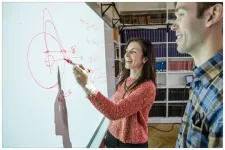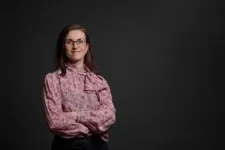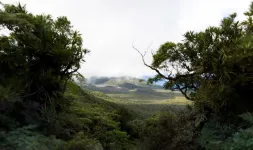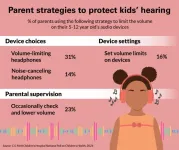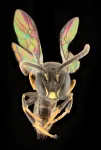(Press-News.org) She studies the giant explosions of dying stars and dreams of experiencing and extracting data from a supernova close to Earth. Professor Irene Tamborra from the Niels Bohr Institute also tirelessly promotes equity and inclusion in research. Today she receives the prestigious Elite Research Prize and DKK 1.2 million in honor of her research in astrophysics.
"I am fascinated by anything that explodes in the sky," Professor Irene Tamborra says as she begins to describe her research. The professor from the University of Copenhagen’s Niels Bohr Institute finds herself at the top of a list of young, world-class Danish researchers – and is now receiving the Ministry of Higher Education and Science's annual Elite Research Prize.
Professor Tamborra has provided pioneering contributions to an entirely new area of astrophysics known as 'multi-messenger astrophysics'. Since joining the Niels Bohr Institute in 2016, she has established a world-leading group in this new emerging field that studies explosive and energetic events in our Universe, such as supernova explosions, the merger of two neutron stars, and other exotic objects that we are just discovering in the sky.
"To find out what goes on in the core of these energetic cosmic booms, we now have the exciting opportunity to combine photons, neutrinos, and gravitational waves. Just as we humans use all our senses to explore our surroundings, we combine the information carried by these different cosmic messengers to find answers about fascinating astrophysical objects, fundamental physics, and the cosmic origin of the elements making the periodic table," explains Irene Tamborra.
The dream of a stellar explosion in our backyard
As massive stars explode they emit cosmic messengers with enormous power sending clues about the engine powering stellar collapses to researchers.
“The collapse of a massive star, leading to a colossal explosion that can outshine the entire galaxy, results in the emission of neutrinos, photons and gravitational waves that we can detect on Earth. The origin of the atoms in our body can be ultimately traced back to supernova explosions and these cosmic explosions are therefore essential to our life. This is why it is so important to figure out how they work," says Professor Tamborra.
Scientists observed for the first time a supernova in neutrinos in 1987. This stellar collapse occurred very close to the Milky Way, in the Large Magellanic Cloud. At the time, astronomers weren’t equipped with the telescopes and measuring instruments available today. Therefore, one of Tamborra’s greatest dreams is for another supernova to occur close enough to Earth for her research group to learn from it.
"It would be absolutely wonderful because we would be able to measure a million times more particles from the explosion than we could forty years ago and we would be finally able to test our understanding of how these objects work," she says.
Irene Tamborra's discoveries have born groundbreaking new understandings in astrophysics. For example, her research shows that neutrinos – the smallest and second most abundant sub-atomic particles in the universe after photons – play an important role in the physics of supernovae and the merger of two neutron stars, and that these particles can deliver crucial insights from these fascinating cosmic phenomena, which cannot be obtained through electromagnetic radiation.
An inclusive environment in a male-dominated field
In addition to the modeling of cosmic explosions of various types, the researcher is actively engaged in promoting equity and diversity in Academia. It is no secret that there are too few women in STEM fields, but the gender ratio in theoretical (astro) physics is even more skewed. This is a fact that the researcher has experienced firsthand in her own professional trajectory.
"Throughout my career, I've become accustomed to being the only woman in the room, or on the entire floor. It has made me feel out of place, which shouldn’t be the case. Therefore, I try to create an inclusive and welcoming environment in my group, independently of gender, scientific or cultural backgrounds," she says and stresses the upsides in having a diverse research group:
"By having a diverse environment, both with regards to gender and scientific backgrounds, we approach problems differently, which is a huge strength that makes us more creative and encourages more interesting discussions than if we were all alike," concludes Irene Tamborra.
The award will be presented today, 26 February 2024, at 13:00 by H.M. The Queen and the Minister for Higher Education and Science. about the Elite Research Prize here.
(Box) More about Irene Tamborra:
Irene Tamborra is Italian. She is Professor at the Niels Bohr Institute, University of Copenhagen, where she leads the Particle Astrophysics group. She is also Mercator Fellow (equivalent of Visiting Professor) at the Max Planck Institutes for Physics and Astrophysics in Garching, Germany.
Irene’s research activity is at the interface between astrophysics and particle physics. Her work focuses on the violent universe, especially on stellar explosions and transient astrophysical events, aiming at unveiling what can be learnt by adopting neutrinos, photons and gravitational waves as probes of the physics of these sources. She is also interested in modeling (quantum) particle transport and particle acceleration in astrophysical outflows, physics beyond the Standard Model, and nucleosynthesis of the heavy elements.
She is the recipient of several international awards for her research, including the MERAC Prize from the European Astronomical Society, the Duggal Award from the International Union of Pure and Applied Physics, and the European Research Council Consolidator Award.
Contact:
Irene Tamborra
Professor
Niels Bohr Institute
University of Copenhagen
tamborra@nbi.ku.dk
Michael Skov Jensen
Journalist and team coordinator
The Faculty of Science
University of Copenhagen
msj@science.ku.dk
+ 45 93 56 58 97
END
Award-winning researcher dreams of stellar explosions and strives for equity and inclusion in academia
Professor Irene Tamborra from the Niels Bohr Institute receives the prestigious Elite Research Prize and DKK 1.2 million in honor of her research in astrophysics
2024-02-26
ELSE PRESS RELEASES FROM THIS DATE:
Clinical trial tests combination antibody therapy in adults with advanced cancer
2024-02-26
In an early phase clinical trial, a combination of antibody-based medications targeting the immune system generated promising safety data and anti-tumor activity in individuals with various types of advanced cancer. The findings are published by Wiley online in CANCER, a peer-reviewed journal of the American Cancer Society.
Both medications tested in the trial support immune responses against tumor cells. CS1002 increases the activation and proliferation of T immune cells by binding to a T cell receptor called CTLA-4. CS1003, also called nofazinlimab, ...
Birds and bee lessons as Pacific field trips also solve 'Michener's mystery'
2024-02-26
Eight new Pacific bee species and new insights into Fijian bird behaviour on Viti Levu Island have been described in new scientific studies led by Flinders University.
The studies, both funded by field work supported by the Australian Government’s New Colombo Mobility Plan Program, highlight the potential for species discovery, ecological and conservation knowledge and cultural engagement from Asia-Pacific research collaborations.
In the past 10 years, Australian Government-funded Flinders University field trips have worked closely ...
Can they hear you now? Kids increasingly exposed to noise health risks via earbuds and headphones
2024-02-26
ANN ARBOR, Mich. – While it’s not surprising to spot teens wearing headphones and earbuds, it’s also becoming a widespread trend among younger children, a national poll suggests.
Two in three parents say their child ages 5-12 uses personal audio devices, with half of parents of children ages 5-8 reporting elementary-aged kids use a device.
Among parents whose children use headphones and earbuds, half say kids spend at least an hour a day using them while one in six say a typical ...
How did a tiny bee get to French Polynesia? Eight new species help solve a scientific mystery
2024-02-26
In 1934, American entomologist Elwood Zimmerman, then an undergraduate student at Berkeley, participated in the ‘Mangarevan expedition’ to Polynesia. Among the samples he collected were three tiny (4 mm long), orange-brown solitary bees found on tahetahe flowers in the Tuamotu Archipelago.
The specimens rested undisturbed in the Bernice P Bishop Museum of Honolulu until 1965, when the famous bee specialist Prof Charles Michener examined them. He described them as a species new to science: Hylaeus tuamotuensis, or Tuamotu’s masked bee, in the family ...
Many older adults receiving home care do not receive palliative care before death
2024-02-26
Many older adults receiving home care do not receive any palliative home care before death, suggesting we need better methods to identify people who need this support, according to new research in CMAJ (Canadian Medical Association Journal) https://www.cmaj.ca/lookup/doi/10.1503/cmaj.221513.
"Palliative care is an essential component of a holistic, comprehensive and patient-centred approach to care for all people with a life-limiting illness from the time of diagnosis with the disease," said Dr. Amy Hsu, investigator at the Bruyère Research Institute and faculty in the Department of Family Medicine at the ...
Reforestation schemes are not enough to recover the carbon created by harvesting wood, research suggests
2024-02-26
Forests have a critical role to play in capturing and storing carbon from the Earth’s atmosphere – but some models exaggerate their carbon removal potential by almost three-fold, according to a leading professor of forest economics.
Global Forest Carbon: Policy, Economics and Finance by Runsheng Yin from Michigan State University emphasizes the value of nature-based solutions to the climate crisis but calls for significant changes to the way carbon credits from reforestation, afforestation, and improved forest management are calculated. He has found that current modeling of local ...
Antidepressant dispensing to adolescents and young adults surges during pandemic
2024-02-26
Antidepressant dispensing to adolescents and young adults increased sharply after the COVID-19 pandemic began – particularly among females – a new study finds.
While a growing number of young people ages 12 to 25 were receiving antidepressants before the pandemic, the antidepressant dispensing rate rose nearly 64% faster after March 2020, according to Michigan Medicine led findings in Pediatrics.
“Antidepressant dispensing to adolescents and young adults was already high and rising before ...
Healthcare leaders plea to reinstate the Canadian hypertension control program to prevent death and disability
2024-02-26
Philadelphia, February 26, 2024 – A passionate plea for the re-establishment of Canada's health coalition focused on hypertension prevention and control appears as an editorial in the Canadian Journal of Cardiology, published by Elsevier. "We need a national hypertension control program to prevent death and disability," according to prominent healthcare leaders.
Lead author of the editorial Norm R.C. Campbell, MD, Department of Medicine, University of Calgary, explains, "Hypertension is a leading cause of death and disability in Canada; globally it causes about one in five deaths (19.2%). However, ...
Drug limits dangerous reactions to allergy-triggering foods, Stanford Medicine-led study of kids finds
2024-02-25
A drug can make life safer for children with food allergies by preventing dangerous allergic responses to small quantities of allergy-triggering foods, according to a new study led by scientists at the Stanford School of Medicine.
The research will be published Feb. 25 in the New England Journal of Medicine. The findings suggest that regular use of the drug, omalizumab, could protect people from severe allergic responses, such as difficulty breathing, if they accidentally eat a small amount of a food they are allergic to.
“I’m excited that we have a promising ...
Measuring the properties of light: Scientists realise new method for determining quantum states
2024-02-25
Scientists at Paderborn University have used a new method to determine the characteristics of optical, i.e. light-based, quantum states. For the first time, they are using certain photon detectors - devices that can detect individual light particles - for so-called homodyne detection. The ability to characterise optical quantum states makes the method an essential tool for quantum information processing. Precise knowledge of the characteristics is important for use in quantum computers, for example. The results have now been published in the specialist journal "Optica Quantum".
"Homodyne detection is a method frequently ...
LAST 30 PRESS RELEASES:
SIMJ announces global collaborative book project in commemoration of its 75th anniversary
Air pollution exposure and birth weight
Obstructive sleep apnea risk and mental health conditions among older adults
How talking slows eye movements behind the wheel
The Ceramic Society of Japan’s Oxoate Ceramics Research Association launches new international book project
Heart-brain connection: international study reveals the role of the vagus nerve in keeping the heart young
Researchers identify Rb1 as a predictive biomarker for a new therapeutic strategy in some breast cancers
Survey reveals ethical gaps slowing AI adoption in pediatric surgery
Stimulant ADHD medications work differently than thought
AI overestimates how smart people are, according to HSE economists
HSE researchers create genome-wide map of quadruplexes
Scientists boost cell "powerhouses" to burn more calories
Automatic label checking: The missing step in making reliable medical AI
Low daily alcohol intake linked to 50% heightened mouth cancer risk in India
American Meteorological Society announces Rick Spinrad as 2026 President-Elect
Biomass-based carbon capture spotlighted in newly released global climate webinar recording
Illuminating invisible nano pollutants: advanced bioimaging tracks the full journey of emerging nanoscale contaminants in living systems
How does age affect recovery from spinal cord injury?
Novel AI tool offers prognosis for patients with head and neck cancer
Fathers’ microplastic exposure tied to their children’s metabolic problems
Research validates laboratory model for studying high-grade serous ovarian cancer
SIR 2026 delivers transformative breakthroughs in minimally invasive medicine to improve patient care
Stem Cell Reports most downloaded papers of 2025 highlight the breadth and impact of stem cell research
Oxford-led study estimates NHS spends around 3% of its primary and secondary care budget on the health impacts of heat and cold in England
A researcher’s long quest leads to a smart composite breakthrough
Urban wild bees act as “microbial sensors” of city health.
New study finds where you live affects recovery after a hip fracture
Forecasting the impact of fully automated vehicle adoption on US road traffic injuries
Alcohol-related hospitalizations from 2016 to 2022
Semaglutide and hospitalizations in patients with obesity and established cardiovascular disease
[Press-News.org] Award-winning researcher dreams of stellar explosions and strives for equity and inclusion in academiaProfessor Irene Tamborra from the Niels Bohr Institute receives the prestigious Elite Research Prize and DKK 1.2 million in honor of her research in astrophysics
